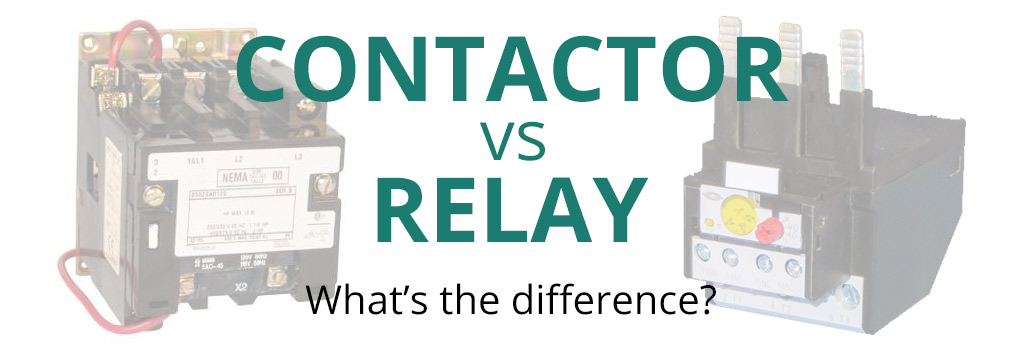
There is a lot of confusion around the industry about the difference between contactor vs relay, and many times, the terms are used nearly interchangeably. The defining differences are not always apparent, so we thought we’d try and help sort out the answer.
According to the Institute of Electrical and Electronics Engineers:
Relay – “A device by means of which contacts in one circuit are operated by a change in conditions in the same circuit or in one or more associated circuits”
Contactor – “A device for repeatedly establishing and interrupting an electric circuit under normal conditions”
What Makes Contactors Different from Relays?
The textbook definitions are similar enough that it doesn’t help us. Both perform the same task of switching a circuit! So what is the difference between contactors and relays?
1. Load Capacity
Relays are generally classified as carrying loads of 10A or less, while a contactor would be used for loads greater than 10A, but this simple definition gives an incomplete picture. It leaves out any physical differences or standards.
2. Open/Closed Contact Standards
Contactors are almost exclusively designed to operate with normally open (Form A) contacts. Relays, on the other hand, can and often are both Normally Open and/or Normally Closed depending on the desired function. This means that with a contactor, when it is de-energized, there is (typically) no connection. With a relay, there very well could be.
3. Auxiliary Contacts
To confuse things a bit, contactors are often fitted with auxiliary contacts, which can be NO or NC; however, these are used to perform additional functions related to the control of the contactor. For example, the contactor may transmit power to the motor, while the auxiliary contact is in the control circuit of the motor starter and commonly used to turn on a pilot light, indicating the motor is operating.
4. Safety Features (Spring-Loaded Contacts)
Because contractors typically carry high loads, they often contain additional safety features like spring-loaded contacts to help ensure the circuit is broken when de-energized. This is important because, in high-load situations, contacts can weld themselves together. This can create the dangerous situation of energizing a circuit when it is supposed to be off. Spring-loaded contacts help to reduce this chance, as well as ensure all circuits are broken at the same time. Since relays are typically for lower power, spring-loaded contacts are much less common.
5. Safety Features (Arc Suppression)
Another safety feature commonly included in contactors, due to the high loads they typically carry, is arc suppression. Magnetic arc suppression works by extending the path an arc would have to travel. The arc is suppressed if this distance is extended further than the energy can overcome. Since relays aren’t designed for high loads, arcing is less of a concern, and arc suppression is much less common on relays.
6. Safety Features (Overloads)
Lastly, contractors are commonly connected to overloads that will interrupt the circuit if the current exceeds a set threshold for a selected time period, usually 10-30 seconds. This is to help protect the equipment downstream of the contactor from damage due to current. Overloads are much less common on relays.
Contactor vs. Relay Applications
Contactors are typically built for and used in 3-phase applications, whereas a relay is more commonly used in single-phase applications. A contactor joins 2 poles together, without a common circuit between them, while a relay has a common contact that connects to a neutral position. Contactors are commonly rated for up to 1000V, while relays are usually rated to only 250V.
Choosing Between Contactors and Relays for Your Application
When selecting between the two, some very general rules you can follow to help
When to Use a Relay:
- 10A or less current
- Up to 250VAC
- 1 phase
When to Use a Contactor:
- 9A or more current
- Up to 1000VAC
- 1 or 3 phase
Always consult the specifications of the items you are considering using and discuss with a licensed electrician. This is for informational purposes only.
In practice, you should be looking at the function as well. For any circuit where an overload condition could occur, and a failure to de-energize the circuit will create a dangerous condition, a contactor is likely the best choice because of the additional safety features. For switching low power, when the additional safety features of a contactor are not necessary, a relay is typically the more economical choice.
Do you still have questions about the differences between a contactor vs relay? Reach out to our experts at Springer Controls today!

